duets: alto flute and piano
Fauré - Sicilienne - Alto Flute
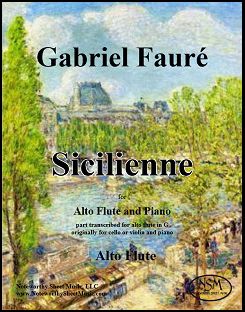 Sicilienne, Op.78, by Gabriel Fauré
Sicilienne, Op.78, by Gabriel Fauré
Transcribed for Alto Flute (and Piano) by C.A.Vater
Alto Flute Part, PDF $3.79
Sicilienne (Opus 78) was composed by Gabriel Fauré in 1893 and first published as a chamber music version for solo cello or violin with piano accompaniment in 1898. Numerous transcriptions of this popular piece have been made, including arrangements for flute and piano, viola and piano, horn and piano, flute and harp, 2 flutes and piano, flute and clarinet, and piano solo, among others. Our alto flute part is a transcription based on the original violin and cello parts of the edition published by J. Hamelle in 1898. We provide only the transcribed alto flute part; the piano accompaniment is readily available as a free pdf download of the original score for piano and cello, now in the public domain.
Alto Flute part, 2 pages of music; Total, 4 pages.
Gade - Fantasy Pieces - Alto Flute
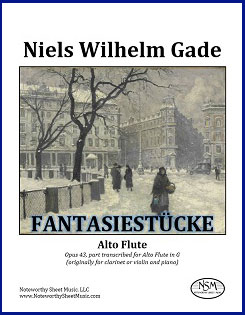 Fantasiestücke, Op.43, by Niels W. Gade
Fantasiestücke, Op.43, by Niels W. Gade
Transcribed for Alto Flute (and Piano) by John W. Pratt
Alto Flute Part, PDF $6.99
Niels Wilhelm Gade (1817–1890) became the preeminent figure in 19th century Danish musical life after an early success in Copenhagen and five years in Leipzig as Mendelssohn's assistant and successor. His Fantasiestücke (Fantasy Pieces, Opus 43) for clarinet (or violin) and piano were published in 1864, apparently his only work published that year although others were in progress. They are dedicated to the clarinetist "Herrn Kammermusiker Mozart Petersen." Our flute transcriptions take into account the nature of the flute and the discrepancies between Gade's original score and the clarinet and violin parts. We provide our alto flute part; the piano score is readily available in the public domain as a free pdf download of the score for clarinet and piano. Here is a link to one such source: Piano Score
Alto Flute part, 7 pages; Total, 10 pages.
PreviewGlazunov - Elegy - Flute or Alto Flute
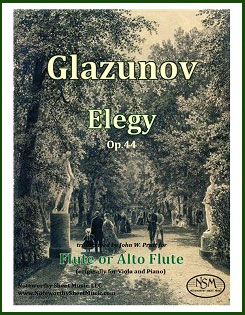 Elegy, Op.44, by Alexander Glazunov
Elegy, Op.44, by Alexander Glazunov
Transcribed for Flute or Alto Flute (and Piano) by John W. Pratt
Parts for Flute and Alto Flute, PDF $5.99
Alexander Konstantinovich Glazunov (1865-1936) was a major composer in the late Russian romantic tradition. His Elegy, Op.44, was written for viola and piano in 1893. The viola melody is readily adaptable for other instruments, since it is without double stops, and has been transcribed here by John W. Pratt for either flute or alto flute. The piece is about 6 minutes long, elegiac but not lugubrious. It consists of a lovely melody in 9/8 time, enhanced by a simple but warm piano accompaniment. The NSM edition includes a flute part and an alternative alto flute part, but does not include one for piano, since a suitable score is freely available at IMSLP.org.
Flute part, 2 pages; Alto Flute part, 2 pages; Total, 8 pages.
PreviewGoepfart - Zwei Charakterstücke - Alto Flute and Piano
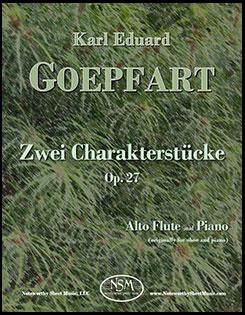 Zwei Charakterstücke, by Karl Eduard Goepfart
Zwei Charakterstücke, by Karl Eduard Goepfart
transcribed for Alto Flute and Piano by C. A. Vater
Alto Flute part and Piano score, PDF $8.99
Karl Eduard Goepfart (1859-1942) was a German pianist, composer and conductor. His Zwei Charakterstücke, Op. 27 (Two Character Pieces) were written for oboe and piano and first published in Leipzig in 1888. The two contrasting pieces are the very charming Mässig schnell, gehend and Mässig langsam (in ruhiger Bewegung) with its playful, energetic Lebhaft section. We prepared a transcription of this under-appreciated work for alto flute, complete with piano score. The pieces work well on alto flute, providing the accompanying pianist is sensitive to the alto flute’s lower sound power and projection capability, especially in the low register, compared to that of the oboe.
Piano Score, 8 pages; Alto Flute part, 3 pages; Total, 16 pages.
PreviewHauptmann - Bereavement - Alto Flute & Piano
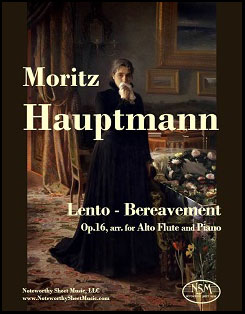 Lento - Bereavement, by Moritz Hauptmann
Lento - Bereavement, by Moritz Hauptmann
Transcribed for Alto Flute and Piano by C. A. Vater
Piano Score and Alto Flute Part, PDF $3.99
Hauptmann's 3 Violin Duos, Op.16 were first published in 1832. The Lento (Bereavement) from Op.16 later was arranged for violin and piano by the renowned violinist, violist, and composer Heinrich Wilhelm Ernst. It is this arrangement by Henri Ernst, published in 1880, that served as the basis for NSM’s transcription of the piece for alto flute and piano. The mournful simplicity of the Lento is perfectly captured and beautifully rendered by the alto flute.
Alto Flute part, 1 page; Piano Score, 2 pages; Total, 6 pages.
PreviewHaydn - Adagio from Sym. No.24 - Afl & Pf
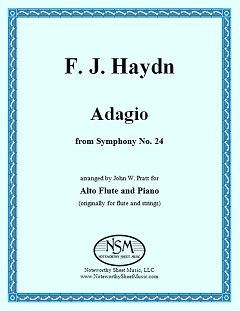 Adagio from Symphony No.24, by F. J. Haydn
Adagio from Symphony No.24, by F. J. Haydn
Arranged for Alto Flute and Piano by John W. Pratt
Alto Flute Part and Piano Score, PDF $6.00
We offer a flute and piano edition of the gorgeous second movement Adagio for solo flute accompanied by strings from Haydn's Symphony No.24. An arrangement for alto flute that is mellower than that for flute but also extremely beautiful is obtained by lowering the pitch a minor third. Haydn's flute part needs no other change, nor does the cadenza that was written by Mr. Pratt for our C-flute edition. The string parts have been adapted to piano sonority in a number of ways, as well as transposing them in this alto flute edition.
Alto Flute part, 2 pages; Alto Flute & Piano score, 4 pages; Total, 10 pages.
PreviewHaydn - Adagio, Quartet Op.17, No.1 - Afl & Pf
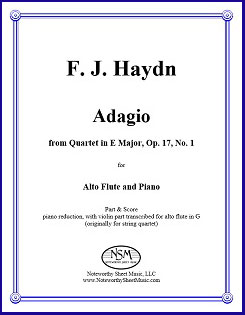 Adagio from Quartet in E Major, Op.17, No.1, by F. J. Haydn
Adagio from Quartet in E Major, Op.17, No.1, by F. J. Haydn
Transcribed for Alto Flute and Piano by John W. Pratt
Alto Flute Part and Piano Score, PDF $8.00
Haydn's early quartets, especially the three sets of six written between 1768 and 1771 (Opus 9, Opus 17, and Opus 20), advanced the development of the classical string quartet enormously in all respects. The third movement of Opus 17, No. 1 is an Adagio with a beautiful violin melody that is harmonized simply by the other three strings. Whereas Haydn's more complex movements generally are unsuitable for transcription, the relative simplicity of this gorgeous Adagio makes it an exception. We present here a transcription for alto flute and piano. The melody is highly effective on the alto flute, and the other string parts are readily adaptable to the piano.
Alto Flute part, 2 pages of music; Piano score, 6 pages; Total, 12 pages.
PreviewHaydn - Adagio, Quartet Op.17, No.2 - Afl & Pf
 Adagio from Quartet in F Major, Op.17, No.2, by F. J. Haydn
Adagio from Quartet in F Major, Op.17, No.2, by F. J. Haydn
Transcribed for Alto Flute and Piano by John W. Pratt
Alto Flute Part and Piano Score, PDF $8.00
The third movement of Haydn's Opus 17, No. 2, like that of Opus 17, No. 1, is an Adagio with a beautiful violin melody that is harmonized simply by the other three strings. The melody is compelling on alto flute, with just a few changes to accommodate its sonic differences from the violin. Lest the effect be too placid when the lower string parts are transferred to the piano, our piano transcription elaborates them in the style of Haydn's keyboard music in several places. We also incorporate a few changes for better sonority and to disentangle the voices where the string parts have overlaps and unisons that are poorly suited to the piano. All told, this transcription is highly effective and a delight for both players.
Alto Flute part, 2 pages of music; Piano score, 6 pages of music; Total, 12 pages.
PreviewKalliwoda - Concertino - Alto Flute
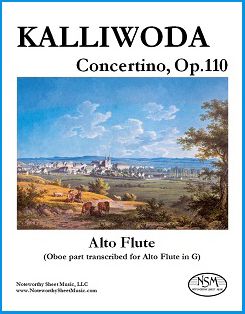 Concertino, Op.110, by J. W. Kalliwoda
Concertino, Op.110, by J. W. Kalliwoda
Transcribed for Alto Flute by C.A.Vater
Alto Flute Part ― PDF $6.99
Johann Wenzel Kalliwoda (1801‒1866) was a Bohemian violinist, orchestra conductor, and prolific composer who wrote numerous compositions, including operas, symphonies, various works for violin and orchestra, piano pieces, and chamber music works. He was considered a significant composer in his day, especially for pieces written early in his career, and his music received the praise of Robert Schumann. Kalliwoda was immensely popular and a favorite of American concert-going audiences in the first half of the 19th century.
His Concertino, Op.110, for oboe and orchestra was first published by Schott in 1841. An arrangement of the work for oboe and piano is available on imslp.org, in addition to an orchestral score and parts for oboe, violins I and II, violas, cellos, and basses. Like many of Kalliwoda's earlier compositions, the Concertino is highly melodic and energetic. We created a transcription of the solo oboe part for alto flute that gives alto flutists an opportunity to experience first-hand the joy of playing this style of classical 19th century bravura work, for which the alto flute is well-suited. Perhaps it should be pointed out that Theodore Boehm, who developed the modern alto flute in G during the mid-1850's, intended that the alto become a new instrument in its own right, utilized in a variety of musical roles and characterized by a unique quality of sound. Indeed, we think Boehm likely would have approved of our creating new opportunities, such as this transcription of the Kalliwoda Concertino, to show off the alto flute's versatility and the alto flute performer's virtuosity.
We provide our alto flute part only; appropriate parts for piano or orchestral accompaniment may be obtained as free pdf downloads from public domain resources, such as imslp.org.
Alto Flute part, 7 pages; Total, 10 pages.
PreviewMendelssohn - On Wings of Song - Alto Flute & Piano
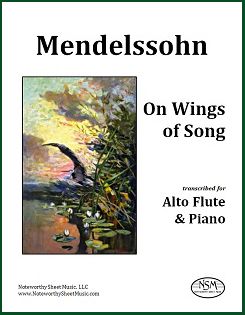 On Wings of Song, Op.34, No.2, by Felix Mendelssohn
On Wings of Song, Op.34, No.2, by Felix Mendelssohn
Transcribed for Alto Flute and Piano by C.A.Vater
Alto Flute Part and Piano Score, PDF $5.99
Having made significant contributions as a poet, essayist, journalist, and critic, Christian Johann Heinrich Heine (1797-1856) is considered one of the great German writers of the 19th century. Many of his romantic poems were chosen as the text for Lieder by such eminent composers as Schubert, Schumann, and Brahms. The Heine poem Auf Flügeln des Gesanges, which translates into English as On Wings of Song, was set to music by Felix Mendelssohn and published as No. 2 of six songs for voice and piano constituting his Opus 34. Auf Flügeln des Gesanges became one of Mendelssohn's most famous art songs, and remains popular to this day. Arrangements and transcriptions of the music have been created for small orchestra, flute and guitar, flute and piano, violin and piano, two violins, cello and piano, treble choir, and piano solo, among others. With its charming, simple melody and narrow pitch range, On Wings of Song is highly accessible and understandably a favorite of vocal and instrumental soloists of all levels. Our transcription is in the key of G, and the song is especially mellow and lovely when played on alto flute.
Alto Flute part, 1 page; Piano Score, 4 pages; Total, 8 pages.
Preview=========================================================
We also offer a professionally-printed hard copy edition of On Wings of Song for $10.18 plus a shipping and handling fee. Please use the Contact Us form to let us know which hard copy publication(s) you would like to purchase, along with your contact information and USPS mailing address. We will then send you a PayPal invoice for the sale and, once we receive notice from PayPal that you have paid for the item(s), we will ship your music to the address provided. We do not ship outside of the USA, due to high postage fees.
=========================================================
